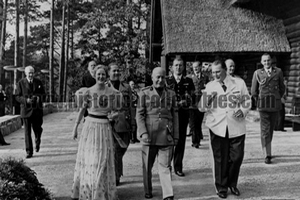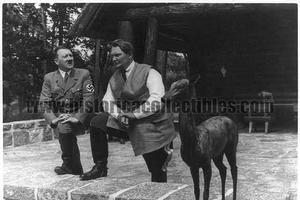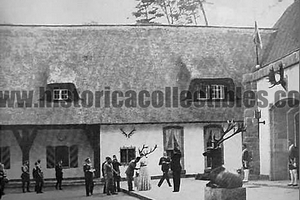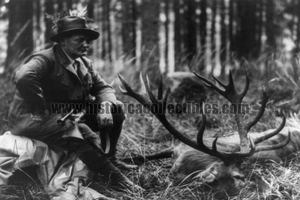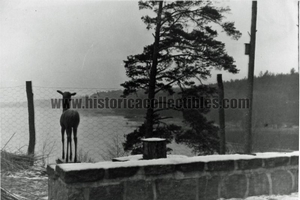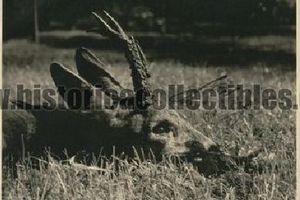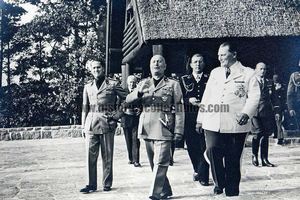Hermann Göring, gift from the Foreign Ministry of the Kingdom of Italy, 1934
From the beginning of his political career Hermann Göring paid much attention to international relations, and even before coming to power, particular attention was paid to Italian fascism. We remember that after the failure of the Putsch of 1923 he took refuge in Italy where he had established contacts with exponents of the fascist regime. It was Göring who paid Mussolini a first official visit in 1931, bringing him the feelings of the future Führer, in exchange he received a photograph with an autograph dedication from the Duce. After 1933, and after the National Socialists came to power in Berlin, Goering's visits to our peninsula became increasingly frequent with increasingly important contacts. In his capacity as "extraordinary" Foreign Minister he managed to forge friendships with leading men of the fascist party such as Italo Balbo, who shared the same passion for flying and hunting, and this passion was punctuated by many visits and sumptuous mutual homages. The trips he made to Italy were closely linked to economic contacts, but he also dedicated many cultural and pleasure visits, which mostly resulted in the purchase of art objects of great value.
This extraordinary and important bronze sculpture depicting a deer in the act of leaping was commissioned, in 1934, by the Foreign Ministry of the Kingdom of Italy, to one of the most important Italian master sculptors Giuseppe Rebesco who created it. The sculpture was in all probability the gift that the Delegation of the Foreign Ministry officially delivered to the then "extraordinary" Foreign Minister Hermann Göring, as well as deputy Führer appointed by Hitler with a decree of the same year, which was invited by him on his personal request, at his residence in Carinhall in Germany. It was an invitation intended to re-establish diplomatic relations with Italy, which had deteriorated in July 1934 due to the assassination by the Germans of the Austrian Chancellor Engelbert Dollfuss, with whom Mussolini had signed the Rome protocols with a three-way agreement between Austria, Italy and Hungary. In fact, Mussolini signed this pact in March 1934 to enter minutely into Austrian affairs to counter the Nazi project of the Anschluss, being then still very wary of the German movement and its leader Adolf Hitler. However, we also leave room for the hypothesis, linked to the same reason relating to the killing of Dolfuss, that this sculpture was donated by a representative of the Foreign Ministry to Hermann Göring, on the occasion of an official visit he made to Italy as Foreign Ministry “extraordinary” in 1934, to re-establish diplomatic relations with Italy.
The bronze sculpture, which rests on a base in fine black Belgian marble, was made with the lost wax casting technique, weighs a total of 22 kg, is 61 cm high and 47 cm long. He represents one of the most symbolic and emblematic figures that Göring wanted to surround himself with. In fact, as is known, Goering was a passionate admirer and hunter of the deer, who has always been an emblematic figure rooted in Germanic mythological culture as a graceful and fast, powerful and majestic animal, with the grandiose horns that he wears with pride and solemnity. Above all, an essential testimony to this is part of the furnishings, consisting of bronze figures of deer and fawns, many of which are life-size, which he himself had commissioned and placed inside and outside his sumptuous country residence in Carinhall. He also had large rooms set up with hundreds of trophies (stages).
There could not have been a more welcome gift than a sculpture representing a deer. Thus on the sculpture, in addition to bearing the dedication "Foreign Ministry of the Kingdom of Italy", the fulcrum of the Nazi flag was carefully engraved with the initials written on it in Gothic "H.G." Hermann Göring.
It is worth remembering the theft of works of art which took place in 1944 by the Germans to the detriment of the Archaeological Museum of Naples of the two "Cervi Ercolanensi", which were sent together with other works of art, directly to Göring's residence in Carinhall .
CARINHALL: In 1933 Hermann Göring, as a private citizen, purchased land in a wooded area on the shores of Lake Wuchersee, approximately 50 km. north of Berlin. He passed his ideas for building a house to the architect Professor Werner March (designer of the Berlin Olympic stadium). The house was completed in 1934 and was called "CARINHALL" in honor of Baroness Carin Von Foch, his wife. Starting from 1934, this sumptuous hunting estate was the venue for formal and informal meetings with foreign authorities from all over the world, in which useful alliances were sought for the realization of German National Socialist thought. So much so that in 1936 it was decided to transform this private home of Göring into "Haus des Reiches" or a state residence, even if as a condition Göring imposed the free use of it until his death.
To be considered an important historical testimony, as well as an exceptional work of art belonging to one of the main figures in the history of the 20th century.



